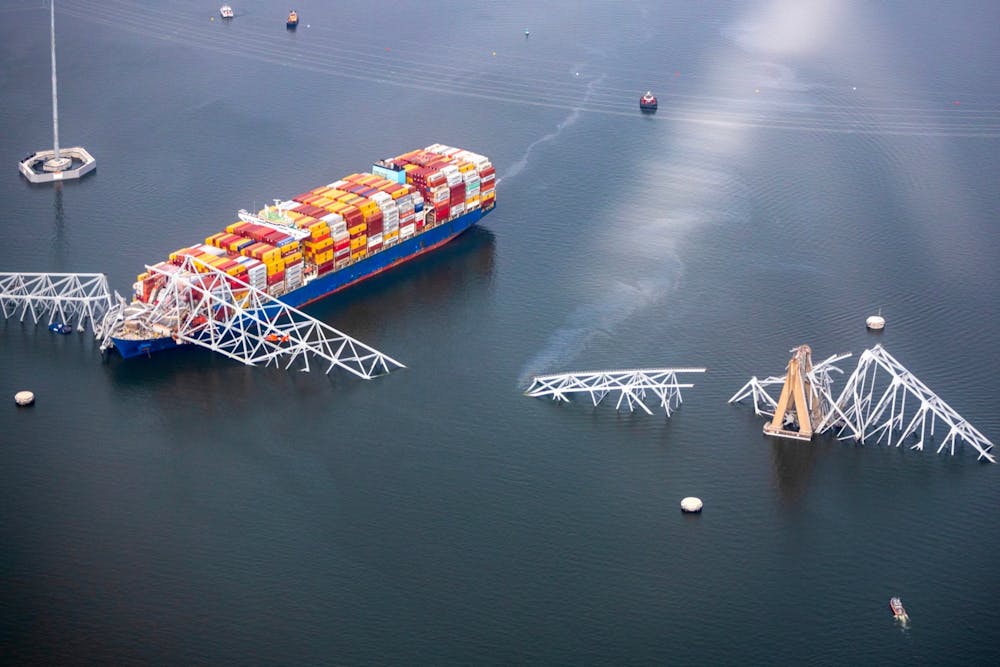Commuters from Maryland will be navigating new ways to get to work and school after a container ship hit Baltimore’s Francis Scott Key Bridge, causing it to partly collapse in the early morning of March 26.
Those commuting from the Baltimore area to American University’s campus could face delays, due to the tragic collapse and the subsequent traffic across additional routes from Baltimore to D.C. Multiple news anchors predicted a morning commute that will be “disastrous for thousands of drivers.”
Sarah Trembath, a professorial lecturer in the University’s Department of Literature, commutes from central Baltimore to get to campus.
“The awful tragedy that happened this morning with the Key Bridge on 695 is sure to change things for the worse for a while too,” Trembath wrote in an email to The Eagle. “I expect even more traffic blockages and more packed trains, even though this bridge is not on the direct commute between Baltimore and D.C.”
Trembath further commented on the resulting traffic between D.C. and Baltimore stating that, “Every time something happens [on] one highway in the area, all of the other pathways between here and there are affected.”
Named after the author of the National Anthem, the Key Bridge was a 1.3-mile long part of I-695, a north-south arterial to I-95 approximately 45 minutes north of D.C. There were reports of vehicles and people in the Patapsco River and currently, search efforts are underway to recover the bodies of four missing construction workers presumed dead. Two were rescued early Tuesday morning and two others were found dead Wednesday afternoon.
Baltimore has multiple tunnels and another bridge commuters can use, but the increase in daily travelers will require an adjustment period to correct traffic issues across Maryland.
Kimberly Ross, an adjunct professor in the Department of Literature, commutes from southern Maryland on the Baltimore-Washington Parkway every morning.
“On Fridays when you have the most traffic, it probably will affect me,” Ross said. “Most likely I will be in traffic longer, just trying to get out.”
Lindsey Sparrock, a fourth-year doctoral student in the Behavioral Cognition and Neuroscience Ph.D. program, commutes from Takoma Park, Maryland and has frequent appointments in Baltimore.
The maintenance of Maryland roads has raised concerns about how alternate routes, and the drivers using them, will hold up with increased traffic congestion. The alternative ways to travel through Maryland “just have really bad roads,” Sparrock said.
“From a psychological standpoint, more car stress is related to a host of other unfortunate kinds of side effects like increased stress and perhaps high blood pressure and anxiety,” Sparrock said.
Many participants in the University’s research programs come from Maryland and the Baltimore area, which creates a “notable concern on whether [increased traffic congestion] is going to be kind of a further strain for research” Sparrock said.
Sparrock also said that the lack of resources for those who regularly commute to AU could exclude research participants who do not have access to alternative transportation methods, resulting in the exclusion of research participants due to lack of accessible transportation options. She also said it could increase the use of the D.C. Metro and campus shuttle and congest the University’s parking lots which “could be an additional burden if you're already taking extra time on the road, and now have to pay longer.”
The ship, known as the Dali, hit one of the support pylons of the Key Bridge around 1:30 a.m. after losing power. All of the crew aboard the Dali have been accounted for, according to the owners of the ship.
Governor Wes Moore of Maryland declared a state of emergency Tuesday morning and is “working with an interagency team to quickly deploy federal resources,” according to a statement from his press secretary.
The Maryland Department of Transportation Maryland Transit Authority suggested Tuesday morning that commuters “use I-95 or I-895 as alternate travel routes.”
This article was edited by Abigail Hatting, Abigail Turner and Abigail Pritchard. Copy editing done by Luna Jinks, Isabelle Kravis, Ariana Kavoossi and Sydney Kornmeyer.





